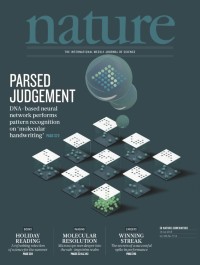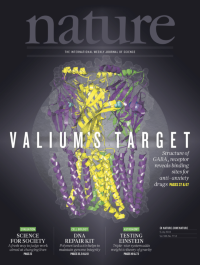Volume 559
-
No. 7715 26 July 2018
Malaria bites backA member of medical staff at the malaria research project’s facility in Siem Pang, Cambodia, checks the health of a young man. Cambodia is among several countries in southeast Asia that have showed a worrying rise in resistance to artemisinin-based combination therapies, the gold-standard treatment for malaria. Although the region accounts for just 7% of malaria cases worldwide, it has repeatedly given rise to strains of drug-resistant malaria parasites that have subsequently invaded other parts of the globe. Cambodia, Thailand, Vietnam, Laos and Myanmar are now trying to eradicate the malaria parasite before resistant forms spread more widely. Researchers are aiding that effort by developing tools to improve detection of the parasite and ways to forestall drug resistance.
Nature Outlook
-
No. 7714 19 July 2018
Parsed judgementWhether it is bacteria following chemical gradients or humans unpicking a complex odour, the ability to recognize molecular patterns is a key attribute of organisms. DNA-based neural networks can perform the same task in molecular computing but have so far been limited to a set of no more than 4 patterns of 4 bits each. In this week’s issue, Lulu Qian and Kevin Cherry increase those numbers to 9 and 100, demonstrating a set-up that can correctly identify the numbers 1–9 written to a 10 × 10 pixel grid. Their network uses the ‘winner take all’ competitive strategy to refine its output and determine which of the numbers it is viewing. The researchers show that even when 30 of the 100 bits of a given pattern are flipped — analogous to the variation in handwritten characters — their network can ‘remember’ the pattern correctly and recognize the digit. This suggests that molecular computation circuits can classify highly complex and noisy information based on something akin to a memory.
-
No. 7713 12 July 2018
Booby trapThe cover shows a red-footed booby (Sula sula), one of several species of seabird that make their home on the islands in the Central Indian Ocean’s Chagos Archipelago. In this week’s issue, Nicholas Graham and his colleagues show that droppings from these seabirds are not only cycled back into island fauna and flora but that they also feed into the adjacent coral reef ecosystem, fuelling reef fish production and function. The team also reveals that on islands that have been infested by rats, the number of seabirds — and thus the amount of nutrients deposited — is markedly reduced. They suggest that eradicating rats on oceanic islands could redress the balance, ultimately helping to enhance coral reef resilience.
-
No. 7712 5 July 2018
Valium’s targetFast inhibitory neurotransmission in the brain is principally mediated by the neurotransmitter γ-aminobutyric acid (GABA) and its synaptic target, the type A GABA receptor (GABAA). These receptors have a major role in psychological activity in the central nervous system — their dysfunction can lead to disorders such as epilepsy, anxiety and insomnia. They are also the target for drugs, including barbiturates, anaesthetics, alcohol, and the benzodiazepines diazepam (Valium) and alprazolam (Xanax). In this week’s issue, Ryan Hibbs and his colleagues report the structure of the predominant isoform of the receptor in the brain. Using cryo-electron microscopy the researchers reveal the human α1β2γ2 GABAA receptor bound to flumazenil, an overdose antidote, and GABA. Each subunit in this heteromeric receptor is a different colour, with the drugs bound shown as teal spheres. The team shows how the receptor is affected by benzodiazepines and reveal sites at specific interfaces between the protein subunits of the receptor that are potential targets for drug development.




